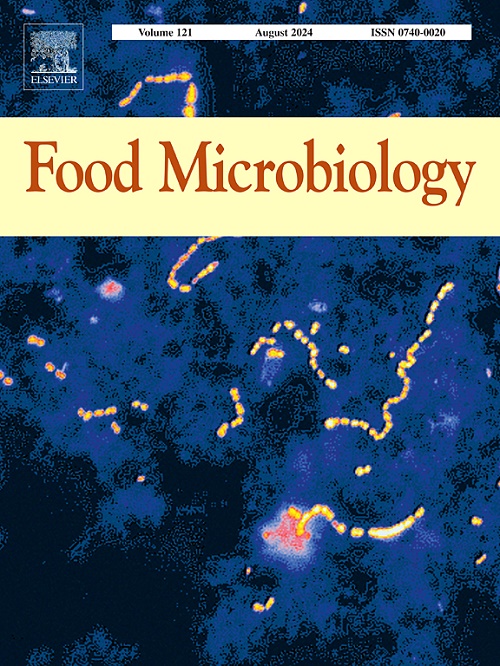希腊屠宰场水平家禽肉中产生β-内酰胺酶的大肠杆菌、肺炎克雷伯菌和不动杆菌的流行、季节变化和蛋白质组学关系
IF 4.5
1区 农林科学
Q1 BIOTECHNOLOGY & APPLIED MICROBIOLOGY
引用次数: 0
摘要
广谱β-内酰胺酶(ESBL)和产碳青霉烯酶的肠杆菌和不动杆菌是重要的医院病原体,经常从患者和食物基质中分离出来。然而,关于家禽肉制品中β-内酰胺耐药菌的流行、时空变化和特征的综合数据有限。这项研究首次全面评估了希腊屠宰场水平家禽肉中β-内酰胺耐药菌株的流行、特征和蛋白质组学关系。利用β-内酰胺选择性分离菌株,并通过MALDI-TOF ms鉴定菌株的抗菌敏感性和常见β-内酰胺酶基因的存在,并分析蛋白质谱以确定菌株之间的关系,同时将大肠杆菌分离菌株进一步分类为系统发育群。大肠杆菌、肺炎克雷伯菌和不动杆菌的总体流行率分别为40.8%、3.3%和46.7%,其中不动杆菌的流行率具有明显的季节性和区域性波动,大部分菌株(大肠杆菌97.9%、肺炎克雷伯菌100.0%和不动杆菌88.1%)属于多药耐药或广泛耐药。所有大肠杆菌和肺炎克雷伯菌菌株表型均证实为ESBL/AmpC产生者,而一株肺炎克雷伯菌菌株对厄他培南表现出额外的耐药性。大多数大肠杆菌(91.49%)和所有肺炎克雷伯菌均携带β-内酰胺酶基因,大肠杆菌以blaCTX-M 1组为主,肺炎克雷伯菌以blaSHV为主。相反,只有10.2%的不动杆菌菌株携带β-内酰胺酶基因。大多数大肠杆菌分离株属于A门群(46.9%)和B1门群(34.7%)。蛋白质谱分析表明,不同地区和季节的分离株具有相关性。这些发现强调了禽肉作为大肠杆菌、肺炎克雷伯菌和不动杆菌耐药菌株储存库的作用,并强调了加强监测和缓解战略以减少公共卫生风险的必要性。本文章由计算机程序翻译,如有差异,请以英文原文为准。
Prevalence, seasonal variation, and proteomic relationship of β-lactamase-producing Escherichia coli, Klebsiella pneumoniae, and Acinetobacter spp. in poultry meat at the abattoir level in Greece
Extended-spectrum-β-lactamase (ESBL) and carbapenemase-producing Enterobacterales and Acinetobacter spp. are important nosocomial pathogens that are frequently isolated from patients and food matrices. Nevertheless, comprehensive data on the prevalence, spatiotemporal variations, and characterization of β-lactam-resistant bacteria in poultry meat products are limited. This study provides the first comprehensive assessment in Greece of the prevalence, characteristics, and proteomic relationships of β-lactam-resistant strains in poultry meat at the abattoir level. Strains were selectively isolated using β-lactams and identified via MALDI-TOF MS. Antimicrobial susceptibility and the presence of common β-lactamase genes were assessed, and protein profiles were analyzed to determine strain relationships, whereas E. coli isolates were further classified into phylogenetic groups. The overall prevalence was 40.8% for E. coli, 3.3% for K. pneumoniae, and 46.7% for Acinetobacter spp., with notable seasonal and regional fluctuations especially in Acinetobacter spp. Most strains (97.9% of E. coli, 100.0% of K. pneumoniae and 88.1% of Acinetobacter spp.) were classified as multidrug or extensively drug-resistant. All E. coli and K. pneumoniae strains were phenotypically confirmed as ESBL/AmpC producers, whereas one K. pneumoniae strain showed additional resistance to ertapenem. The majority of E. coli strains (91.49%) and all K. pneumoniae strains carried β-lactamase genes, predominantly blaCTX-M group 1 in E. coli and blaSHV in K. pneumoniae. Conversely, only 10.2% of Acinetobacter strains harbored β-lactamase genes. Most E. coli isolates belonged to phylogroups A (46.9%) and B1 (34.7%). Protein profile analysis indicated relatedness among isolates across different regions and seasons. These findings underscore poultry meat's role as a reservoir of resistant strains of E. coli, K. pneumoniae, and Acinetobacter spp. and highlight the need for enhanced surveillance and mitigation strategies to reduce public health risks.
求助全文
通过发布文献求助,成功后即可免费获取论文全文。
去求助
来源期刊

Food microbiology
工程技术-生物工程与应用微生物
CiteScore
11.30
自引率
3.80%
发文量
179
审稿时长
44 days
期刊介绍:
Food Microbiology publishes original research articles, short communications, review papers, letters, news items and book reviews dealing with all aspects of the microbiology of foods. The editors aim to publish manuscripts of the highest quality which are both relevant and applicable to the broad field covered by the journal. Studies must be novel, have a clear connection to food microbiology, and be of general interest to the international community of food microbiologists. The editors make every effort to ensure rapid and fair reviews, resulting in timely publication of accepted manuscripts.
 求助内容:
求助内容: 应助结果提醒方式:
应助结果提醒方式:


